Verizon delivers network reliability during COVID-19 while accelerating 5G deployments
Consistent investment, continuous deployments of the latest technology led to strong performance when customers needed it most.
Special deployments and additional investments directed to support first responders.
In the midst of the pandemic, Verizon has accelerated some of its 5G deployments.
Consistent investment, continuous deployments of the latest technology led to strong performance when customers needed it most.
Special deployments and additional investments directed to support first responders.
In the midst of the pandemic, Verizon has accelerated some of its 5G deployments.
Full Transparency
Our editorial transparency tool uses blockchain technology to permanently log all changes made to official releases after publication.
More of our content is being permanently logged via blockchain technology starting [10.23.2020].
Check out this infographic for additional data.
6/11 Update: Verizon Network Report:
BASKING RIDGE, NJ – Throughout the first 90+ days of the country’s COVID response, Verizon’s networks maintained pre-COVID reliability levels even in the midst of dramatic usage spikes and shifts in demand. At the same time, Verizon’s industry-leading team of engineers and technicians were able to continue and even in some cases accelerate deployment of our 5G network.
Network reliability maintained for customers, businesses and first responders
According to the Verizon COVID-19 Network Reliability Report (reporting period March 1 - May 31), the company’s consistent network investment, year after year; continued deployment of advanced technology; planning ahead of need and demand as a matter of practice, not crisis; and the experience and expertise of the Network organization supported that increased usage across different parts of the networks (compared to typical pre-COVID geographic high usage locations) and during different peak usage hours.
“In crisis situations, communication is critical. We have experienced it throughout COVID-19 when spikes in volume on our networks demonstrated the importance of connecting with critical resources, colleagues, friends and family,” said Kyle Malady, Verizon’s Chief Technology Officer. “Reliability is in our DNA and we prepare all year long for emergencies. The strength, reliability, and consistent performance of our networks has been very evident to our customers during the COVID-19 pandemic.”
“I am very proud of the reliability and performance of our networks throughout the first three months of the pandemic,” said Malady. “Our wireless network was equally reliable during March, April and May compared to January and February. The height of network reliability of our Fios fiber optic network occurred in February, and again in March, when massive changes in customer usage began as tens of millions of people and students transitioned to working and learning from home.”
Serving the frontlines
With dynamic situations like COVID-19, the communications needs of those on the frontlines changes and evolves quickly. During this crisis, Verizon met the changing needs of first responders, hospital and healthcare workers, educators and essential businesses including:
- Enabled connectivity at multiple federal, state and local mobile command centers and critical remote testing and triage centers.
- Stood up services to allow thousands of doctors to work remotely, alleviating stress on hospitals.
- Enabled remote processing of healthcare insurance claims for mobile and remote users, augmenting contact centers.
- Expanded telehealth options by increasing access to tablets and devices for patients.
- Expanded the number of lines on our prioritized wireless network for first responders
- Worked with school systems nationwide to support distance learning through connectivity and devices.
Examples of deployments in action include:
Atención médica
- We delivered connectivity via a secure, dedicated circuit for the Navy hospital ship USNS Comfort, a medical treatment facility that includes 1,000 hospital beds, 12 operating rooms, radiology capabilities and a pharmacy.
- Worked in partnership with the state of New Mexico’s Aging and Long-Term Services Department to distribute hundreds of tablets to nursing facilities for residents to stay connected to their friends and families while they sheltered-in-place.
- Expanded network capacity near hospitals including Providence St. Vincent Medical Center in Portland, OR.
Emergency Response
Delivered a mobile cell site and landline connectivity to Fort Totten Park in NY, which was used as a base of operations for the military, fire department, and up to 300 ambulances.
Supported temporary emergency operations centers, hospital facilities and testing centers in areas like state parks, convention centers and vacant buildings by deploying network coverage.
Call Center Communications
- Worked with multiple state and local agencies to stand up COVID-19 hotlines to divert call traffic from 911 or to add capacity to 311 systems.
- Established an integrated voice response system for federal and state agencies to allow better management of incoming calls.
Distance Learning
- Worked (and continue to work) with several school districts, including the Los Angeles Unified School District and the State of California, to enable distance learning solutions.
- Provided a Verizon mobile cell site to the Army base at Fort Jackson in Columbia, SC, the largest US Basic Training facility in the country, to enable families of basic training graduates to virtually attend the graduation of their loved ones.
Building the future while maintaining reliability
In the midst of the pandemic, Verizon has been able to continue and even in some cases accelerate its 5G deployment including:
Accelerating fiber deployment: Due to shelter in place orders, many municipalities experienced a dramatic decrease in traffic. Some municipalities allowed us to extend our hours of operation for laying fiber.
Accelerating antenna attachments to cell sites: Antenna work is done outdoors where social distancing is easier to maintain, so we focused efforts on 5G antenna attachments.
Digital permitting: We worked with municipalities to deploy digital permitting solutions. These online solutions allowed us to submit applications for licensing without entering a permitting office, and allowed permitting offices to review, process and approve permits remotely while offices were closed.
Virtual site walks: As part of the approval process, our engineers conducted virtual site walks with municipalities, providing pictures, videos and access to our engineers remotely.
“There is no doubt COVID-19 has had a huge impact, but with these steps, coupled with the most dedicated Network team in the industry, we were able to mitigate the impact of COVID-19, maintain network reliability for the over 100 million customers that rely on us, and even accelerate our build program,” said Malady.
5/21 Update: Verizon Network Report
COVID-19 related network anomalies have returned to pre-Covid springtime levels, according to the latest Verizon Network Report. Over 776 million calls were made and 5.87 billion texts sent on Monday of this week, showing a significant decline from peak pandemic volumes.
“As we see the shifts in network volume and usage, our engineers continue to make real-time adjustments to ensure our network is ready when and where people need it,” said Verizon Chief Technology Officer Kyle Malady. “Though the nation will be managing the impact of COVID-19 far into the future, we feel as if the biggest changes in how, when and where people use the networks are behind us. We will continue to be vigilant in monitoring the networks 24x7 for changes to continue to provide a great customer experience.”
While calls and texts are returning to normal levels, today’s report shows that gaming (up 82% over pre-COVID levels), VPN connections (up 72% over pre-COVID levels) and use of collaboration tools (remaining flat at 10X pre-COVID levels) are still highly elevated, indicating that while restrictions have been lifted to some degree in every state, working and schooling from home as well as gaming are still popular ways to use the Verizon networks.
People are on the move
As call and texting network volumes return to normal levels, mobility has increased significantly over the past few weeks. According to Verizon’s handoff metrics (the times when a data session moves from one cell site to another as users walk or drive around), 44 states have had increases in mobility over the last two weeks and 36% of states have surpassed their pre-COVID mobility levels.
“In the spring, we often see an increase in handoffs as people move around more and volume on our networks increases over what we see in the winter,” said Malady. “So while these numbers are higher than our typical winter pre-COVID numbers, they are very much in line with what we would expect to see this time of year.”
5/14 Update: Verizon Network Report
The latest Verizon Network Report shows American slowly falling back into old habits. On Wednesday, slightly over 760 million calls were made, falling well below the peak daily call volume during the COVID pandemic at over 860 million calls. Text messaging continues its week over week decline falling another 5% to just under 6 billion texts sent on Wednesday. That is compared to over 9 billion texts sent at the peak of the COVID pandemic.
As call and text volumes fall back towards pre-COVID levels, working and schooling from home continues. VPN usage increased 3% week over week and hit a new peak at 81% higher than a typical pre-COVID day. Use of collaboration tools fell 6% week over week, although still shows an increase of approximately 1200% over a typical pre-COVID day.
Today’s report also shows a week over week increase in gaming of 23%, reversing the decline reported last week, and web browsing increased 11% week over week. Meanwhile video streaming remains flat at 36% above a typical pre-COVID day.
These usage changes are happening concurrently with people starting to become more mobile. Handoffs (the times when a data session moves from one cell site to another as users walk or drive around) are steadily increasing from the peak of stay-at-home orders (-35% vs. a typical day to -19% vs. a typical day). Mobile handoffs in some areas of the country (Carolinas, Tennessee, Georgia, Alabama, Kansas and Missouri) are surging higher than a typical pre-COVID day. Although still well below pre-COVID levels, New York Metro mobile handoffs increased 16%, Upstate New York increased 1% and New England increased over 5% week over week.
5/11 Update: Verizon Network Report
This year, Mother’s Day was different. There weren’t luncheons at local restaurants or big family gatherings to honor the women most important to us. But that didn’t stop people from connecting with their moms. Mother’s Day 2020 saw an increase in calls by more than 13% over a typical pre-COVID Sunday and almost 10% more calls than last Mother’s Day, according to the latest Verizon Network Report. Customers talked for over 1.75 billion minutes yesterday - up almost 11% over the previous Sunday. The report also shows over six billion text messages were sent, a more than 25% increase over last Sunday.
In addition to calling, celebrating mom from a safe distance with a video chat was popular this year. Collaboration tool usage saw a 2.6% increase over last Sunday.
“Mother’s Day is historically our highest call volume Sunday of the year, but this year we expected and saw a significant increase in calls,” said Kyle Malady, Chief Network Officer for Verizon. “Our engineers were monitoring our Networks all day yesterday to ensure those important connections were made reliably. This is our business – to connect people in the moments that matter the most.”
5/06 Update: Verizon Network Report
As stay-at-home mandates roll back, some businesses start reopening, and spring weather takes hold across many parts of the country, people are rolling back their usage of video streaming (-11% week-over-week), gaming (-4% week-over-week) and use of collaboration tools (-5% week over week), according to the latest Verizon Network Report.
At the same time, handoffs (the times when a data session moves from one cell site to another as users walk or drive around) increased by 6.2% - the biggest weekly gain since the COVID crisis began. Handoffs increased in every region in the nation with the exception of Upstate New York, New England and the Great Plains regions. Handoffs nationally are still -18% lower than a typical day.
“The network performance numbers definitely indicate a break in routines people have formed over the last several weeks during the pandemic,” said Kyle Malady, Chief Technology Officer for Verizon. “As more restrictions are lifted and people begin resuming normal activities, we expect to see these changes continue. Our Network team has been working 24x7 since this crisis began to ensure we were able to meet the shifting demands as the virus took hold. We will continue to monitor and respond to changing needs as life adjusts on the other side of this.”
Verizon Fios On Demand viewership also points to customers reverting back to their old patterns. Fios On Demand movie viewership this past weekend is 3% higher than the pre-COVID average, a drop from a peak 68% increase in March.
Here are the most popular Fios on Demand films for last weekend:
Bad Boys for Life
The Gentlemen
Like a Boss
Trolls World Tour
The Way Back
4/29 Update: Verizon Network Report
BASKING RIDGE, NJ – As some states ease stay-at-home restrictions, mobile handoffs (the times when a data session moves from one cell site to another as users walk or drive around) are starting to return to near pre-COVID levels in some regions, according to the latest Verizon Network Report. The Carolinas and Tennessee region are 1% below a typical day while the Georgia and Alabama region are down only 5% and the Central Gulf Coast region are down only 9% below a typical day. By contrast, many of the hardest hit areas are still seeing major declines in handoffs compared to a typical day including the Upstate NY region (-58%), New England (-50%) and New York Metro (-47%).
In addition, the Verizon Network Report shows that most categories of usage are starting to decline, with some falling significantly below peak levels. In particular downloads decreased 5% week over week, and have fallen 55% since the COVID peak, while gaming is down 10% week over week and down 45% since its peak. Customers have placed 14% fewer wireless calls from the peak of COVID calling and wireless calls are now 3% shorter in duration.
Collaboration and work tools continue their dominance
One area that continues to rise is collaboration tools and VPN usage, growing another 4% week over week, bringing that up 1194% over a typical non-COVID day. Virtual private network (VPN) connections (which allow people to create a secure connection over a public network like the internet to reach a private network) also crept up another 3% compared to last week, indicating working from home, distance learning and virtual gatherings are still gaining in popularity.
Streaming video remains popular
Streaming video usage continues to increase, up another 4% week over week and up 37% compared to a typical non-COVID day. Fios TV customers are similarly watching on demand video at levels exceeding non-COVID weekends.
Here are the most popular picks for Fios on Demand viewing this past week:
Bad Boys for Life
The Gentlemen
Like a Boss
Trolls World Tour
The Way Back
4/22 Update: Verizon Network Report
According to the latest Verizon Network Report, overall data volume across its networks has increased 19% compared to pre-COVID levels. While data usage remains at elevated levels, the changes in how people are using the network has stabilized. Peak data usage in the following categories shows small week to week changes, though peak usage numbers remain high compared to typical pre-Covid-19 levels:
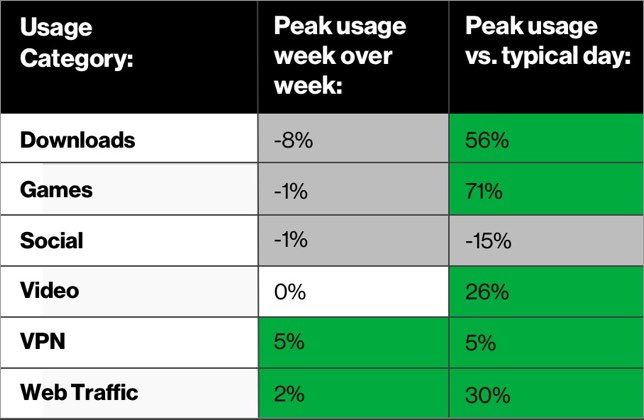
“We believe all trends point to sustained network usage at this higher level for the foreseeable future,” said Kyle Malady, Chief Technology Officer for Verizon. “As customers’ traffic and usage patterns have changed, we have continued to deliver the level of service our customers have come to expect. More importantly, we’ve stepped up our efforts to help people return to business as unusual as best they can.”
In the United States, there has been a notable decline in people’s movements during the course of the global pandemic. Mobile handoffs - the times when a data session moves from one cell site to another as users walk or drive around - have reduced by -27% nationally compared to pre-COVID typical day levels. And, measured by mobile handoffs, the U.S. has seen a decrease in movements since March 1.
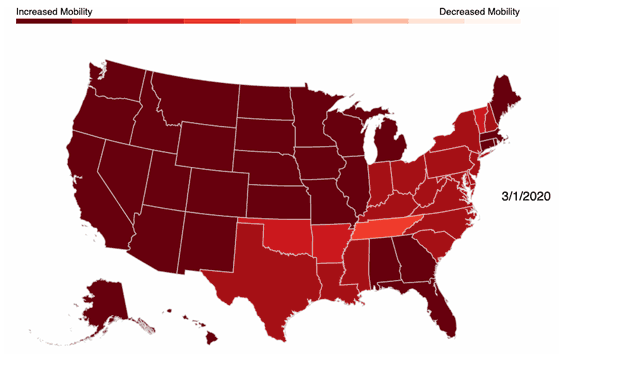
The Verizon Network Report expects usage to continue at sustained higher levels, even as movements begin to shift in the coming weeks and months as cities and states begin to lift restrictions.
For customers who continue to stay in place, video remains a popular in-home source of entertainment as some films debut on demand rather than in theatres.
Below are the most popular Fios Video On Demand titles from the weekend (April 18-19):
Trolls World Tour
The Gentlemen
The Way Back
Subacuático
1917
Below are the most popular TV series viewed on demand last week (April 12-18):
Homeland
Westworld
Outlander
Keeping Up with the Kardashians
Real Housewives of Atlanta
4/15 Update: Verizon Network Report
While continuing to work and learn from home slows the spread of COVID-19, network usage continues to normalize. Today’s Verizon Network Report shows a week-over-week (Monday vs. Monday) decrease of 5% in voice minutes and a 3% decrease in text messages. For the second straight week, Verizon reports that data usage is basically flat or down slightly week-over-week — including gaming, streaming video, virtual private network (VPN) connections (which allow people to create a secure connection over a public network like the internet to reach a private network), web browsing and social media — indicating people have settled into their new routines.
Life goes on, even in the midst of a global health crisis
While safe distancing at home, many Verizon customers observed the holiday weekend in new ways. Use of collaboration tools like video teleconferencing during Easter Sunday was up 36% compared to the prior Sunday, and up 13% during Passover compared to the previous week. Text messages were also up 28% Sunday over Sunday. These numbers indicate many chose to celebrate the holidays via virtual meals, gatherings and services with friends and family online.
Connecting with family likely influenced viewing choices during the holidays. After multiple weeks of high-energy action films proving to be the most popular titles, family-friendly content leads this week's Fios Video on Demand (VOD) charts.
Here are the most popular VOD films last week:
Trolls World Tour
Star Wars: The Rise of Skywalker
Onward
Little Women
Jumanji: The Next Level
Severe Weather Response
In addition to the global health crisis and a holiday weekend, severe weather and tornadoes ripped through the South causing significant damage and power outages for millions. With damage to network facilities, the Verizon Network team quickly deployed mobile cell towers and mobile satellite cell equipment to re-establish communications in the wake of the storm. Mobile satellite cell sites were also deployed at Emergency Operations Command centers in the region to provide additional coverage and to aid in search and rescue operations. Power is still out of service in many locations and Verizon continues to run many sites on backup generator power throughout the region to provide service until both fiber and power can be restored. These efforts have been critical to keeping the network up and running for our customers.
“Our Network team is responding to all major events affecting our communities,” said Kyle Malady, Chief Technology Officer for Verizon. “I’m very proud of our team of engineers and technicians that are working hard to provide connections during this dynamic global health crisis, severe weather and national holidays all at the same time. We know how critical our communications systems are in each of these situations, and we continue to be there to support our customers and first responders.”
4/9 Update: Verizon Network Report
After weeks of significant increases in voice and data usage as a result of millions of people transitioning to working from home, distance learning and virtual socializing, new routines and usage behaviors are stabilizing, according to the latest Verizon Network report.
“While usage in key categories is still up compared to a typical day, the large increases we saw over the first four weeks of this transition have started to normalize,” said Kyle Malady, Chief Technology Officer at Verizon. “While we are still in an unprecedented situation and are monitoring the network extremely closely 24x7, we may be seeing the tail end of the large variations in customer usage behaviors we have seen the last few weeks.”
Today’s report shows week-over-week declines in traffic on virtual private networks (VPNs), which allow people to create a secure connection over a public network (like the internet) to reach a private network, downloads of songs and apps, web, social media and voice minutes of use; no changes week-over-week in video streaming; and only a slight increase in gaming:
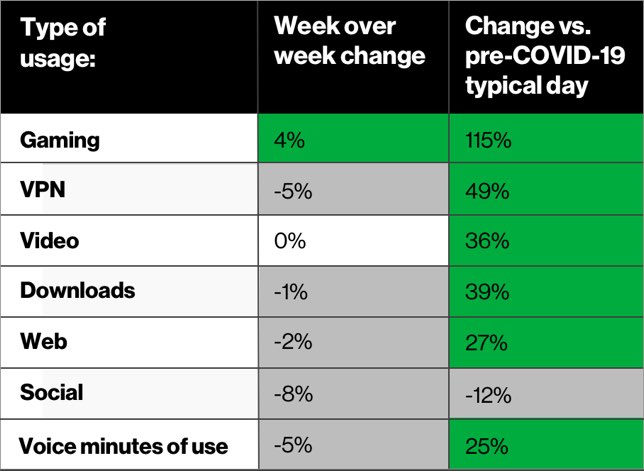
As new routines emerge, on-demand entertainment is taking center stage. On-demand movie viewing is up 32% compared to the typical pre-COVID-19 average weekly viewing. Customers have also embraced TV series filled with action, suspense and comedy.
Last weekend, the top 5 Fios Video on Demand HD titles were:
1. 1917
2. Bad Boys for Life
3. Onward
4. Star Wars: The Rise of Skywalker
5. Jumanji: The Next Level
The top 5 Fios on-demand TV series viewed last week include:
1. Homeland
2. Westworld
3. Keeping Up with the Kardashians
4. Curb Your Enthusiasm
5. Outlander
“I really could not be more proud of Verizon’s engineers and technicians,” continued Malady. “Through a very unpredictable time, this team monitored and adjusted network resources as customer behaviors shifted to ensure reliability and availability of critical communications services when they have been needed most. We are not out of this yet – we’re all in it together – and our team will continue to vigilantly monitor and adjust to support the needs of our customers and first responders.”
BASKING RIDGE, NJ – More and more people across the country appear to be following shelter-in-place mandates as cell site handoffs continued to decline. Cell site handoffs are the times when a data session moves from one cell site to another as users walk or drive around. According to the latest Verizon Network Report, handoffs have decreased by 35% nationally compared to a typical day, down another 6% from what was reported last week. Handoffs are influenced by geography and network design, and provide a directional view of the changing patterns of American life.
4/7 Update: Verizon Network Report
Verizon’s New York Metro and Upstate New York markets showed the biggest declines at 51% and 61% respectively vs. a typical day. Other Verizon markets like the Mid-Atlantic/Greater Washington, D.C. metro area and New England also showed significant declines of 39% and 41%, respectively, with the Southern California and Northern California markets both declining 41% vs. a typical day.
In the southeast, mobile handoffs are significantly down with week-over-week drops of 18% in the Georgia/Alabama market, declines of 16% in the Carolinas/Tennessee market, 10% in Florida, and 9% in the Gulf Coast market.
As more people are staying home, Verizon Media Group reports they are engaging with news about COVID-19 in record numbers. Over 300 million users globally have accessed Verizon media properties’ coronavirus content. In March 2020, the average total time spent per weekend day increased by 123% year-over-year.
4/2 Update: Verizon Network Report
The Northeast and Mid-Atlantic regions appear to have the most people in the nation staying at home, according to the latest Verizon Network Report. Mobile handoffs, the times when a data session moves from one cell site to another as users walk or drive around, are significantly down in the New York Metro area (-53%) and Upstate New York (-49%) vs. a typical day. Other metro regions like the Mid-Atlantic/greater Washington, D.C. metro area and New England follow with declines of -39% and -37%, respectively, with Southern California declining -35% and Northern California down -27%. Nationally, mobile handoffs have dropped -29% versus a typical day.
“The significant decrease in handoffs is a very good indication that people in some of our hardest hit communities are listening to local authorities’ requests to stay home,” said Kyle Malady, Chief Technology Officer for Verizon. “As people stay home to work, engage in online meetings and share social experiences virtually, our networks continue to support them.”
The report also found people who are staying indoors continue to collaborate at much greater levels.
“This week we have seen traffic from collaboration tools increase nearly 10 times over a typical day,” said Malady. “Being able to see and speak with colleagues, friends and family has become increasingly important to people even as they physically distance themselves at greater rates.”
As online collaboration climbs, growth in other internet uses has started to stabilize.
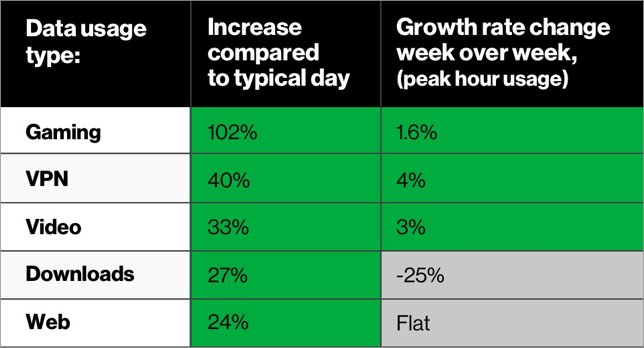
*Downloads include songs, apps, etc.
“We expect to see some traffic growth of specific applications continue even as the changes start to slow for some others,” said Malady. “Our engineers are keeping a close eye on pattern changes and indicators, and we’re ready to adjust our resources to meet the continuously changing needs of our customers.”
BASKING RIDGE, NJ – While things are far from normal, it seems Verizon customers are creating a new weekend normal of fun and fellowship, according to the latest Verizon Network Report.
3/31 Update: Verizon Network Report
The latest Network report shows that peak traffic on VPN, which allows people to create a secure connection over a public network (like the internet) to reach a private network, was down 44% this past weekend over the peak VPN usage on weekdays. The report also shows a 2% increase in peak video traffic, a 7% increase in web traffic and a 3% increase in gaming over peak weekday traffic.
And while taking a break from work, people are still finding ways for Sunday fellowship. With a massive move to online Sunday morning services among many religious organizations the past few weeks, Verizon is seeing a steady increase in Sunday morning collaboration tool usage (8 AM– 12 PM ET), including a 163% increase between Sunday March 15 to the 22 and another 224% March 22 compared to this past Sunday, March 29.
On the entertainment front, Fios TV customers are turning to Video on Demand content, with a 49% increase week-over-week from March 14 through March 21, and stayed consistent through the weekend.
This weekend, the top 5 Fios Video on Demand HD titles were:
- 1917
- Jumanji: The Next Level
- The Invisible Man
- Onward
- Knives Out
In addition, people continue to stay up-to-date with the news. The Verizon Media brand portfolio continues to see a surge in engagement with more than two billion page views and one billion video streams related to COVID-19 news and content. Engagement on Yahoo Mail is also up 22% as people shop, share and socialize from home.
“Our engineers build our networks to provide great experiences and stay ahead of demand, whether customers are streaming their favorite TV show, video chatting with family and friends, or providing critical services on the frontline of this crisis,” said Kyle Malady, Verizon Chief Technology Officer.
3/26 Update: Verizon Network Report
More than halfway through the second full week of large-scale working-from-home, the use of online collaboration tools such as conference calling applications continues to rise significantly, according to the latest Verizon Network Report. Week over week, there has been a 47% increase in use of collaboration tools on Verizon’s networks. The use of these applications drops sharply during weekends, indicating they are being used primarily for remote work and online learning.

Traffic using Virtual Private Networks (VPN), which allow people to create a secure connection over a public network (like the internet) to reach a private network, also continues to increase. It is up another 9% week over week and up 52% over a typical day.
Verizon’s wireless and broadband networks handled more than 218,000 terabytes of data this past Monday alone. That equates to 106 million hours of streaming content, 190 billion photo uploads or 38 billion songs downloaded. The network continues to perform well.
“We are seeing tremendous amounts of usage across our networks as our customers are finding new and important ways of staying connected,” said Kyle Malady, Chief Technology Officer for Verizon. “Our engineers are carefully watching changes and trends in network usage, which seems to be normalizing, and are adjusting capacity as needed. Our networks are meeting the shifting demands well and continue to show strong, consistent performance for our customers.”
BASKING RIDGE, N.J. – The Verizon network is now handling twice the number of wireless calls on weekdays compared to Mother’s Day, according to the latest Verizon Network report. Verizon’s fiber optic and wireless networks continue to perform well, meeting the shifting demands of customers during this unprecedented time.
3/24 Update: Verizon Network Report
Americans Increasingly Staying in Place
Mobile handoffs – the times when a data session moves from one cell site to another as users walk or drive around, are down 27% vs. a typical week, indicating people are increasingly staying in place. As people are being asked to stay physically distant, they are finding alternate ways to stay connected through a significant rise in calls, text and picture messages.
Verizon is reporting:
- An average of nine billion texts each day on its wireless network.
- An average of 800 million wireless calls each weekday – nearly twice the call volume of Mother’s Day.
- Call durations are up 33% vs. a typical day, meaning not only are people calling more, they are staying on the phone longer.
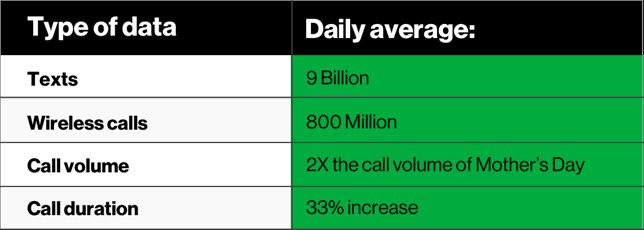
“Typically, Mother’s Day is always our highest Sunday call volume,” said Kyle Malady, Chief Technology Officer for Verizon. “The weekday calling numbers are now significantly exceeding the national holiday honoring Mom.
“The Verizon networks are built to keep people connected and though we are seeing changes in how people are connecting, we see the desire to stay connected growing,” said Malady. “Our networks are meeting customers’ changing habits. In small pockets where there has been a significant increase in usage, our engineers are quickly adding capacity to meet customers’ demand.”
Update: Verizon Network Report, reflecting March 12 compared to March 19
As Americans spend their first full week in the new temporary normal and staying at home, they are finding their voices again. Voice usage, long declining in the age of texting, chat and social media, is up 25 percent in the last week. Verizon customers are benefitting from a long-standing practice of no data caps on Verizon home broadband services.
The network report shows the primary driver of increased voice usage is accessing conference calling numbers. In addition, people are talking longer on mobile devices with: wireless voice usage notching a 10 percent increase and calls lasting 15 percent longer.
“For years we’ve seen a steady decline in the amount of time people spend talking to one another, especially on wireless devices,” said Kyle Malady, Chief Technology Officer at Verizon. “The move to staying at home has reignited people’s hunger to stay connected, voice-to-voice. Verizon’s fiber optic and wireless networks are continuing to meet the shifting demands of customers and continue to perform well.”
No data caps on Verizon home broadband internet
Verizon customers are also benefiting from the company’s long-standing practice of no data caps on its home broadband internet.
How Americans are spending their time, by the numbers:
- Total voice usage on Verizon networks is up 25%, primary driver: accessing conference call services
- Wireless voice usage up 10%, call durations up 15%
- VPN traffic is up 25%
- Web traffic is up 22%
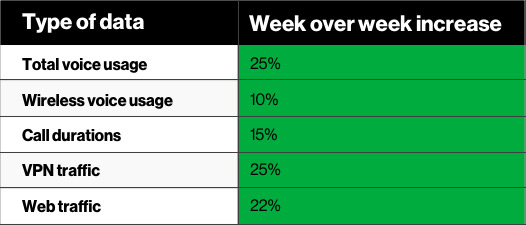
*Based on peak data hour usage March 12 vs. March 19.
*Usage is expected to fluctuate over time; we could see new applications emerge based on customer usage patterns as more people telecommute and more students are at home.
“We are in the first full week of this new American routine and we are certainly starting to see some patterns emerge. We anticipate we will see additional significant shifts in usage over the next few weeks as people adjust and adapt to the changing circumstances,” said Malady. “Our engineers are continuing to closely monitor network usage patterns 24x7 and stand ready to adjust resources as changing demands arise.”
3/17 Update: Verizon Network Report, reflecting March 9 compared to March 16, 2020
The latest week-over-week numbers during peak hour usage showed many people are turning to gaming as a way to pass the time, with the technology leader seeing a 75% increase over its networks. Video streaming increased by more than 12% and overall web traffic by just under 20%.
Surprisingly, social media remained flat.
Verizon’s fiber optic and wireless networks have been able to meet the shifting demands of customers and continue to perform well. In small pockets where there has been a significant increase in usage, our engineers have quickly added capacity to meet customers’ demand.
Here’s a snapshot of usage, week over week:
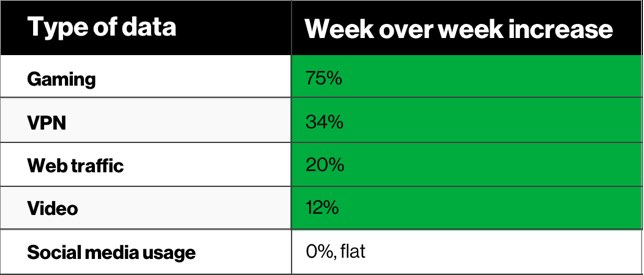
*Based on peak data hour usage week over week.
*Usage is expected to fluctuate over time; we could see new applications emerge based on customer usage patterns as more people telecommute and more students are at home.
“As we see more and more individuals work from home and students engage in online learning, it is a natural byproduct that we would see an increase in web traffic and access to VPN. And as more entertainment options are cancelled in communities across the US, an increase in video traffic and online gaming is not surprising,” said Kyle Malady, Chief Technology Officer for Verizon.“We expect these peak hour percentages to fluctuate, so our engineers are continuing to closely monitor network usage patterns 24x7 and stand ready to adjust resources as changing demands arise."
“We’re in an unprecedented situation,” said Malady. “We continually evaluate peak data usage times and build our networks to stay ahead of that demand. “While it is not clear yet how having millions of additional people working from home will impact usage patterns, we remain ready to address changes in demand, if needed.”